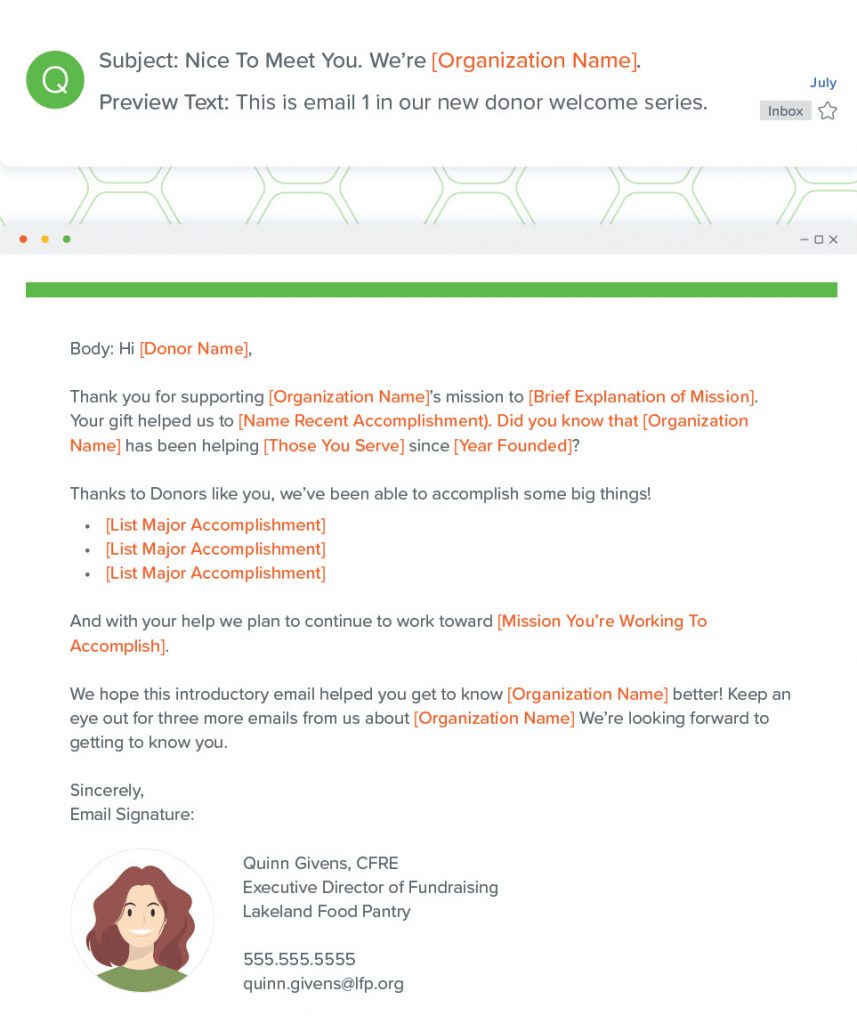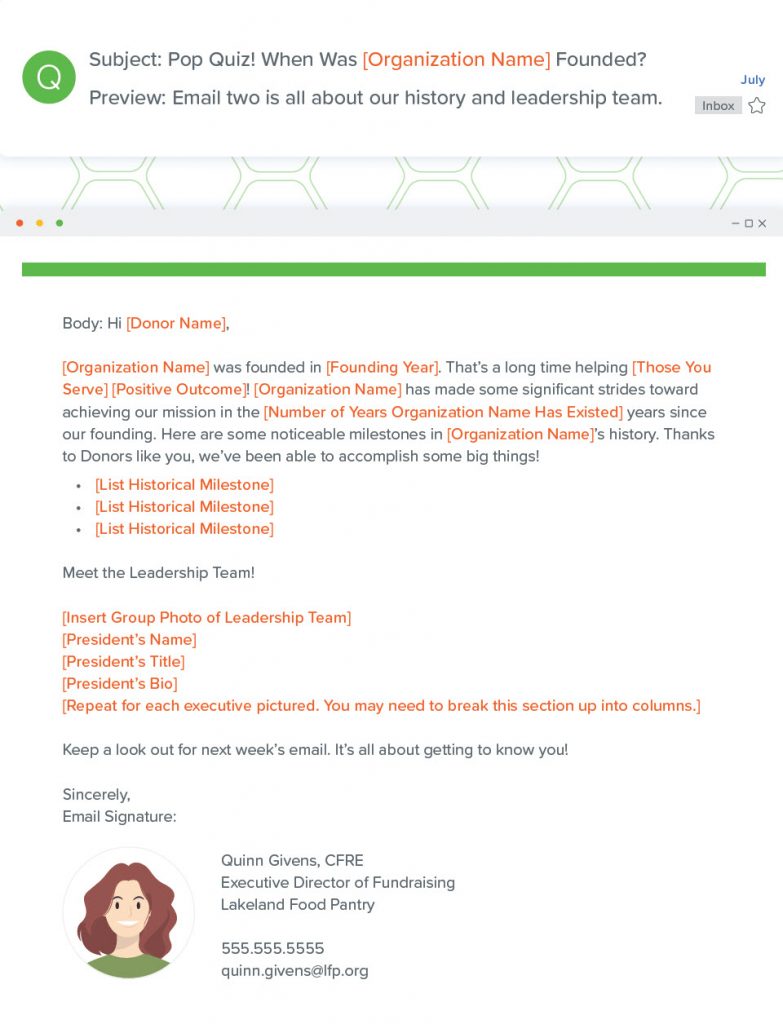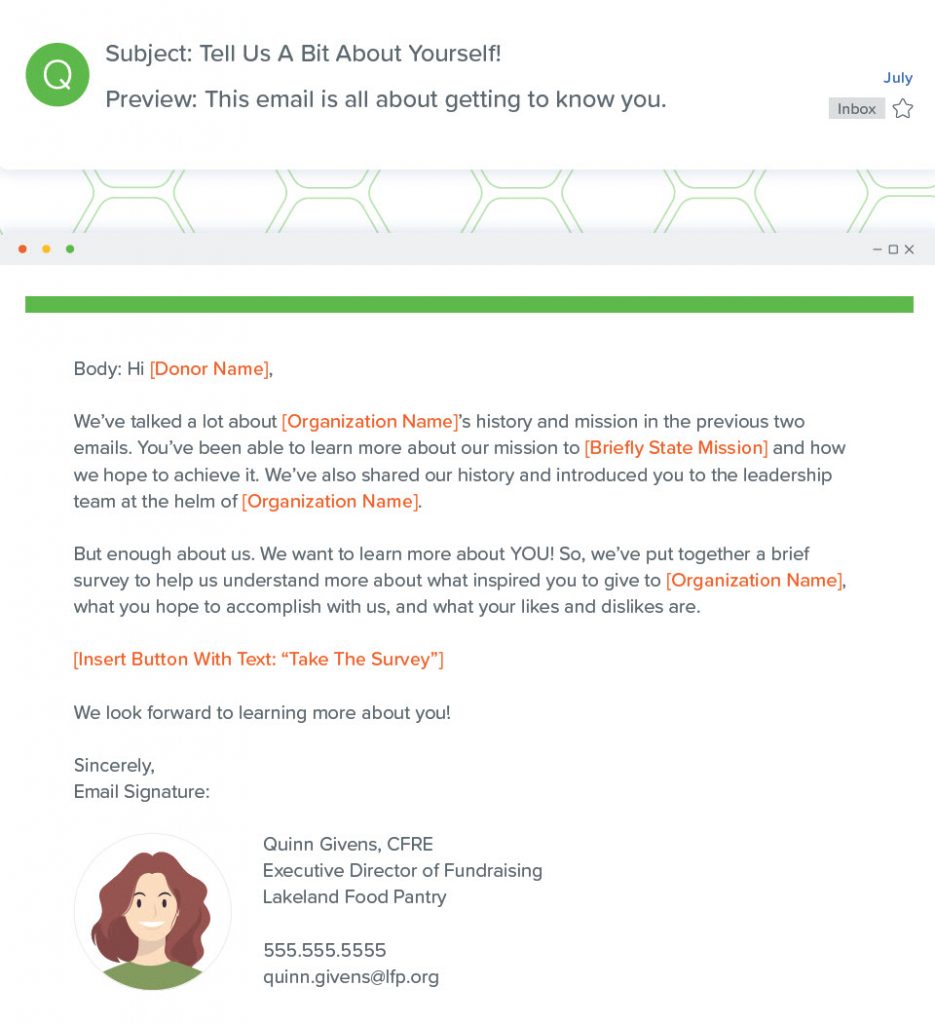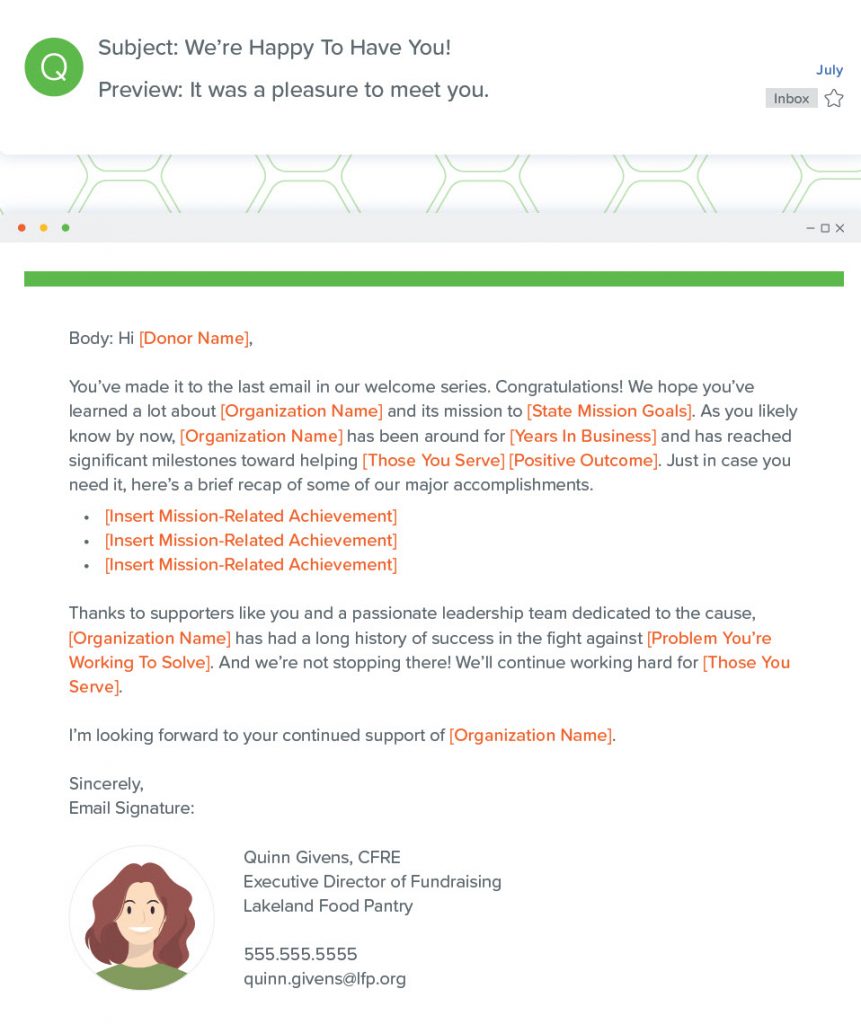New donors might know what you do, but chances are they don’t have the full picture! Don’t leave your donors in the dark. Creating a welcome email series for your new donors can help them get to know your nonprofit and learn what communications to expect from your nonprofit.
Read on to learn how to develop an effective welcome series for donors to keep them learning about, supporting, and giving to your nonprofit.
We even included some helpful templates to get you started!
What is a welcome email series?
A welcome email series is how businesses make introductions to new contacts. Companies send a series of emails at a regular cadence to introduce their business and products to their new contacts.
For-profit businesses often welcome new customers using this method. Nonprofits can use this strategy to connect more deeply with new donors too! A nonprofit’s welcome email series should outline what the nonprofit does, the organization’s history, who their leaders are, their accomplishments, and how donations help. Nonprofits can also use the welcome series to provide new donors with other ways to get involved and can also include ways to learn more about new donors.
How to create an effective donor welcome series
Now that we’ve gone over what a welcome series is, how do you start creating an effective donor welcome series? Read on for tips to make your welcome emails engaging for donors. Don’t forget to check out the fundraising email templates we’ve included!
Tips from an actual nonprofit
Before we dive in, check out this advice from Susan Dannemiller, Executive Director for Children’s Day Preschool. After recently setting up welcome email for her nonprofit, she shared six great tips to help nonprofits get started on their own welcome email series!
Susan’s Tips
- Read as many articles from reputable sources as you can about how to set up the look and feel of the emails, develop content, and specifically, content for welcome emails.
- Form a trusted team to review and help you edit—but make sure they understand the purpose of the emails and can help provide guidance as well as check for grammar and spelling.
- It takes a long time to get the emails where you want them. I may be pickier than most, but it took us several weeks to really develop the look and feel of our email campaign, especially the header! And I had a head start… I send a weekly email to my staff and used that basic design as the base for our agency’s email campaign. But, once you have that set, you can focus on the content.
- Canva is an awesome app/website! We use it for all of our social media, and for these emails, to design our header and some of the graphics we use in our emails.
- We really tried to employ the use of personalized tags and using the word ‘you’ more often than ‘we/us.’ And giving the subscriber reasons to click on things and engage with the email (like the survey in one of their example emails you’ll see later in the article).
- Really try to think of this as a personal conversation you could be having with each individual subscriber. It helps me to imagine who the subscriber is and I’m sending them the email to help them get to know our school/work.
Susan’s great advice can help tremendously when planning your welcome series. To summarize, she recommends that you study what makes a good welcome series, build a team to help you in the email series creation process, give yourself time to polish your emails, take advantage of free resources to make designing your email graphics easier, personalize your emails for your donors so that they’ll engage with your content, and think hard about who your audience is and how you can best communicate about your nonprofit.
Decide the number of emails in the series and the send cadence
Before you write the email series, it helps to identify how many emails you’re going to send and how frequently. Some topics you should cover in your welcome series can probably be combined in a single email, which decreases the total number of emails you need to send. For instance, your organization’s mission and history may be able to be combined in a single email. Too many emails can be overwhelming. We’d suggest having no more than four emails in your welcome series.
Once you’ve determined the total number of emails in the series, determine the right cadence for sending the emails. Is this going to be a daily email? Weekly? Monthly? How do other emails to donors factor into your send schedule?
The cadence you choose should keep your nonprofit at the top of your donor’s mind without feeling overwhelming. Sending your welcome series as a weekly email may be the best compromise for getting donors to know your nonprofit without sending them so many emails they view your communications as spam.

Introduce your donors to your mission
Your first priority for the welcome series should be introducing your donors to your nonprofit mission and impact. This is more than sharing your mission statement. This is a great place to talk about what your nonprofit (and your donors) have accomplished toward achieving your mission.
Your mission is probably what your donors are most familiar with, but it doesn’t hurt to give them a complete picture. Provide a brief overview of the programs you offer, who you help, and how you make a difference in their lives. This is all part of the nonprofit story your donors want to know about.
No matter which email you choose to kick off your email series, set expectations for your donors. Let them know how many welcome series emails to expect and how frequently you’ll be sending them.
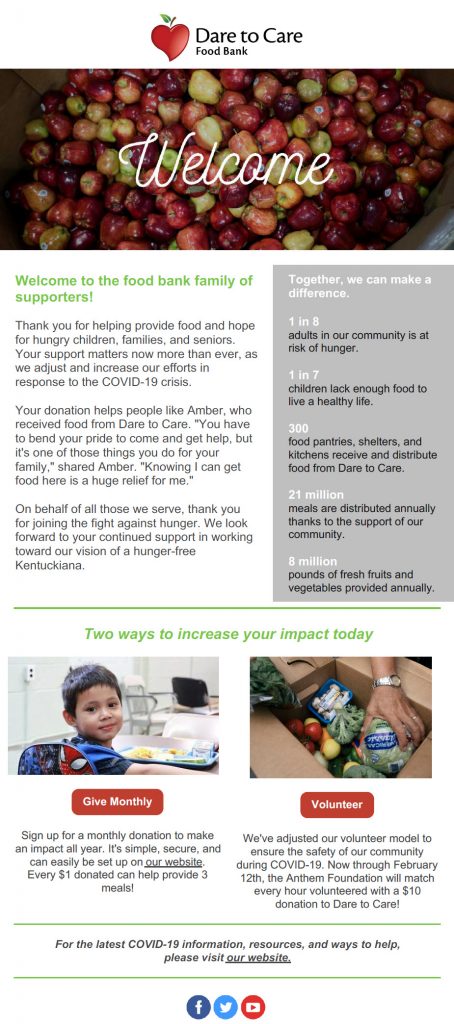
Welcome Email Series Template 1: Introduction to the Mission
Give donors your history and leadership info
Your donors may know your mission, but you can further bolster your credibility by sharing a brief history of your nonprofit organization as well as disclosing who your leaders are.
When sharing your history include information like when you were founded, any major accomplishments toward your mission, any awards you’ve won, etc. A nonprofit’s history shows it’s been sustainably run for a length of time and has made major steps forward toward achieving your mission.
Donors are also interested in knowing who is at the helm of your nonprofit organization. Introduce your donors to your organizational leadership. What are their qualifications? How long have they worked for the nonprofit? How do they support the mission? Why are they passionate about your cause?
Answering questions like these helps donors to connect with your leadership team. If supporters have similar motivations to support your mission as your executives that provides the social proof that they’re giving to a worthy organization.
Welcome Email Series Template 2: Your Nonprofit’s History and leadership
Explain other ways donors can get involved and get to know them
In your welcome series, creating an opportunity to invite donors to take part in the conversation is a great way to learn more about your donors and get them more involved.
Your donors gave to support your cause because they care about what you hope to accomplish. That means that your donors are likely interested in giving more than just their money. If you have ways donors can do more, such as volunteering or advocating for your nonprofit, tell them how they can get more involved in your email series.
You can also use your email series to make donors feel recognized and welcome at your nonprofit. You can accomplish this by asking them to complete an optional survey to introduce themselves. Likewise, you could invite them to send an email or call to chat with a member of your team. That way you learn about them and their expectations as a donor while answering their questions about your nonprofit.
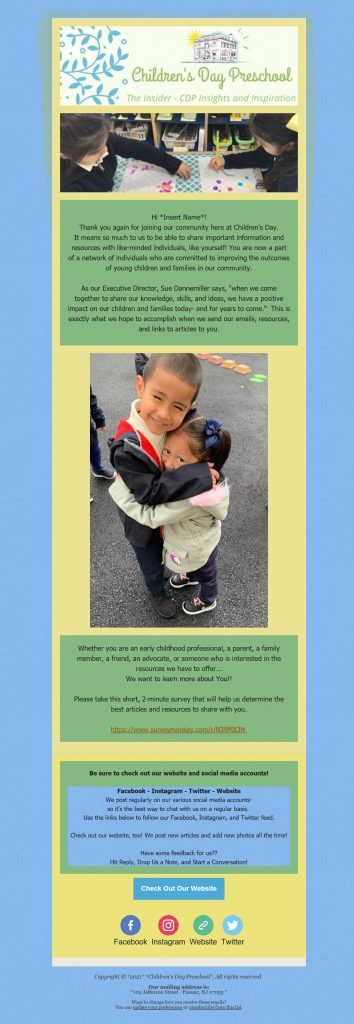
Welcome Email Series Template 3: Getting to know your donors
Summarize the welcome series info in a final email
There’s a chance that your donors are looking for the reader’s digest version of your email series. A busy donor may not catch every one of your weekly emails. In that case, it helps to offer a summary of the series as the final entry in the welcome series.
Briefly recap what you discussed in the email series then wrap up the welcome series with this email. In the wrap up it helps to explain how often donors can expect future communications from your nonprofit.
Welcome Email Series Template 4: Recap and wrap up
Final Thoughts
Getting one-time donors invested in your nonprofit’s mission keeps them giving beyond their first gift. A welcome email series for new donors can help answer donor questions and getting them more involved in your cause. Before you dive into writing welcome series emails, determine how many emails you need. Then determine how frequently you’ll send emails to your donors. Lastly, write your welcome emails so donors learn more about your cause and how they can get more involved.
Looking for more great tips to retain your donors? Check out these additional resources:
- Tailor Nonprofit Email Marketing to New and Existing Donors
- Email Marketing Best Practices for Nonprofits
- Fundraising Emails for Post-event Communication
Download your free donor welcome series templates so you can put together your own winning donor welcome series!
